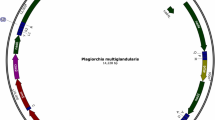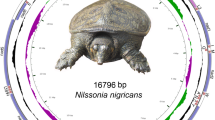Abstract
This work represents the complete mitochondrial genomes of two stingrays, Dasyatis pastinaca and Dasyatis tortonesei, from the Mediterranean Sea. The mitogenomes of these two species were obtained through whole generation sequencing and annotated. These mitogenomes were found to be 17,713 bp and 17,630 bp respectively and each contained 37 genes, that is 13 protein-coding genes (PCGs), 22 transfer RNA (tRNA) genes and two ribosomal RNA (rRNA) genes, a control region and the origin of L-strand replication (OL). All PCGs begin with the codon ATG, except for cytochrome c oxidase subunit 1 (COX1) gene, while two PCGs end with an incomplete termination codon. All tRNA genes are able to fold into their typical cloverleaf secondary structures, except for tRNA-Ser1AGY which lacks the dihydrouracil arm. The control region was 1982 bp and 1889 bp for D. pastinaca and D. tortonesei respectively. Phylogenetic analysis using Bayesian Inference confirmed the occurrence of the genus Dasyatis within the monophyletic subfamily Dasyatinae. This study adds on genetic resources available for these two stingray species.




Similar content being viewed by others
References
Yang L, Matthes-Rosana KA, Naylor GJP (2016) Determination of complete mitochondrial genome sequence from the holotype of the southern Mandarin dogfish Cirrhigaleus australis (Elasmobranchii: Squalidae). Mitochondrial DNA A DNA Mapp Seq Anal 27(1):593–594. https://doi.org/10.3109/19401736.2014.908360
Zhang J, Yang B, Yamaguchi A, Furumitsu K, Zhang B (2015) Mitochondrial genome of longheaded eagle ray Aetobatus flagellum (Chondrichthyes: Myliobatidae). Mitochondrial DNA 26(5):763–764. https://doi.org/10.3109/19401736.2013.855740
Satoh TP, Miya M, Mabuchi K, Nishida M (2016) Structure and variation of the mitochondrial genome of fishes. BMC Genom 17:719. https://doi.org/10.1186/s12864-016-3054-y
Wong TN, Clayton DA (1985) In vitro replication of human mitochondria DNA: accurate initiation at the origin of light-strand synthesis. Cell 42:951–958. https://doi.org/10.1016/0092-8674(85)90291-0
Hixson JE, Wong TW, Clayton DA (1986) Both the conserved stem-loop and divergent 5’-flanking sequences are required for initiation at the human mitochondrial origin of light-strand DNA replication. J Biol Chem 261(5):2384–2390
Lee WJ, Conroy J, Howell WH, Kocher TD (1995) Structure and evolution of teleost mitochondrial control regions. J Mol Evol 41:54–66. https://doi.org/10.1007/BF00174041
NCBI (2020) National Center for Biotechnology Information. https://www.ncbi.nlm.nih.gov/ Accessed 18 Oct 2020
Last PR, Naylor GJ, Manjaji-Matsumoto BM (2016) A revised classification of the family Dasyatidae (Chondrichthyes: Myliobatiformes) based on new morphological and molecular insights. Zootaxa 4139(3):345–368. https://doi.org/10.11646/zootaxa.4139.3.2
Lim KC, Lim PE, Chong VC, Loh KH (2015) Molecular and morphological analyses reveal phylogenetic relationships of stingrays focusing on the family Dasyatidae (Myliobatiformes). PLoS ONE 10(4):e0120518. https://doi.org/10.1371/journal.pone.0120518
Froese R, Pauly D (2019) FishBase. http://www.fishbase.org. Accessed 15 June 2020
Capapé C (1978) Contribution à la biologie des Dasyatidæ des côtes tunisiennes. III. Dasyatis tortonesei Capapé, 1975. Répartition géographique et bathymétrique, sexualité, reproduction, fécondité. Bulletin de l’Institut national scientifique et technique d’Océanographie et de Pêche de Salammbô 5:97–110
Vella A, Schembri A, Vella N (2016) Genetic barcoding of elasmobranches in Malta (Central Mediterranean). CIESM Congr 41:321
Vella A, Vella N, Schembri S (2017) A molecular approach towards taxonomic identification of elasmobranch species from Maltese fisheries landings. Mar Genomics 36:17–23. https://doi.org/10.1016/j.margen.2017.08.008
Yıldız T, Yemişken E, Karakulak FS, Uzer U, Dalyan C, Oray IK (2016) A new record of dasyatid fish from the Sea of Marmara: Tortonese’s stingray, Dasyatis tortonesei Capapé, 1975 (Dasyatidae). J Appl Ichthyol 32:721–723. https://doi.org/10.1111/jai.13087
Bradai MN, Saidi B, Enajjar S (2012) Elasmobranchs of the Mediterranean and Black Sea: status, ecology and biology. Bibliographic analysis. In: Studies and reviews. General Fisheries Commission for the Mediterranean. No. 91 FAO, Rome, p 130
Ebert DA, Stehmann MFW (2013) Sharks, batoids, and chimaeras of the North Atlantic FAO Species Catalogue for Fishery Purposes. No. 7 FAO, Rome, p 523
Serena F (2005) Field identification guide to the sharks and rays of the Mediterranean and Black Sea. FAO Species Identification Guide for Fishery Purposes, Rome, p 97
Serena F, Mancusi C, Morey G, Ellis JR (2015) Dasyatis pastinaca. The IUCN red list of threatened species 2015: e.T161453A48933979 Accessed 18 June 2020
IUCN (2020) The IUCN red list of threatened species. https://www.iucnredlist.org/ Accessed 15 June 2020
Kearse M, Moir R, Wilson A, Stones-Havas S, Cheung M, Sturrock S, Buxton S, Cooper A, Markowitz S, Duran C, Thierer T, Ashton B, Mentjies P, Drummond A (2012) Geneious basic: an integrated and extendable desktop software platform for the organization and analysis of sequence data. Bioinformatics 28:1647–1649. https://doi.org/10.1093/bioinformatics/bts199
Chan PP, Lowe TM (2019) tRNAscan-SE: searching for tRNA genes in genomic sequences. Methods Mol Biol 1962:1–14. https://doi.org/10.1007/978-1-4939-9173-0_1
Yang CP, Zhi TT, Zhang S, Yan S, Yang T (2016) Complete mitochondrial genome of the pelagic stingray Pteroplatytrygon violacea (Myliobatiformes: Dasyatidae). Mitochondrial DNA A DNA Mapp Seq Anal 27(2):935–936. https://doi.org/10.3109/19401736.2014.926493
Yang B, Zhang J, Yamaguchi A, Zhang B (2013) Mitochondrial genome of Dasyatis bennettii (Chondrichthyes: Dasyatidae). Mitochondrial DNA 24(4):344–346. https://doi.org/10.3109/19401736.2012.760552
Chen X, Ai W, Xiang D, Chen S (2014) Complete mitochondrial genome of the red stingray Dasyatis akajei (Myliobatiformes: Dasyatidae). Mitochondrial DNA 25(1):37–38. https://doi.org/10.3109/19401736.2013.779262
Chen X, Ai W, Xiang D, Chen Y, Chen S (2013) Complete mitogenome of the pale-edged stingray Dasyatis zugei (Myliobatiformes: Dasyatidae). Mitochondrial DNA 24(3):196–198. https://doi.org/10.3109/19401736.2012.744982
Shen KN, Chang CW, Tsai SY, Wu SC, Lin ZH, Chan YF, Chen CH, Hsiao CD, Borsa P (2016) Next generation sequencing yields complete mitogenomes of Leopard whipray (Himantura leoparda) and Blue-spotted stingray (Neotrygon kuhlii) (Chondrichthyes: Dasyatidae). Mitochondrial DNA A DNA Mapp Seq Anal 27(4):2613–2614. https://doi.org/10.3109/19401736.2015.1041119
Feutry P, Kyne PM, Peng Z, Pan L, Chen X (2016) Complete mitochondrial genome of the freshwater Whipray Himantura dalyensis. Mitochondrial DNA A DNA Mapp Seq Anal 27(3):1589–1590. https://doi.org/10.3109/19401736.2014.958682
Chen X, Xiang D, Arunrugstichai S, Cai L, Xu Y (2016) Complete mitochondrial genome of the mangrove whipray Himantura granulata (Myliobatiformes: Dasyatidae). Mitochondrial DNA A DNA Mapp Seq Anal 27(1):1–2. https://doi.org/10.3109/19401736.2013.865178
DeHart HM, Yang L, Naylor GJ (2016) Mitogenomic sequence and phylogenetic placement of the Hortle’s whipray Himantura hortlei (Elasmobranchii: Dasyatidae). Mitochondrial DNA A DNA Mapp Seq Anal 27(4):2437–2439. https://doi.org/10.3109/19401736.2015.1030632
Si R, Ding W, Yu J, Chen X, Ai W, Myliobatiformes Dasyatidae (2016) Complete mitochondrial genome and the phylogenetic position of the Jenkins whipray Himantura jenkinsii. Mitochondrial DNA B 1(1):297–298. https://doi.org/10.1080/23802359.2016.1166085
Chen X, Cai J, Ding W, Xiang D, Ai W (2016) Complete mitochondrial genome of the Sharpnose stingray Himantura gerrardi (Myliobatiformes: Dasyatidae). Mitochondrial DNA A DNA Mapp Seq Anal 27(6):3989–3990. https://doi.org/10.3109/19401736.2014.989518
Grant JR, Stothard P (2008) The CGView server: a comparative genomics tool for circular genomes. Nucleic Acids Res 36:181–184
Thompson JD, Higgins DG, Gibson TJ (1994) CLUSTALW: improving the sensitivity of progressive multiple sequence alignment through sequence weighting, position- specific gap penalties and weight matrix choice. Nucleic Acids Res 22(22):4673–4680. https://doi.org/10.1093/nar/22.22.4673
Zardoya R, Meyer A (1996) Phylogenetic performance of mitochondrial protein-coding genes in resolving relationships among vertebrates. Mol Biol Evol 13:933–942. https://doi.org/10.1093/oxfordjournals.molbev.a025661
Miya M, Nishida M (2000) Use of mitogenomic information in teleostean molecular phylogenetics: a tree-based exploration under the maximum parsimony optimality criterion. Mol Phylogenet Evol 17:437–455. https://doi.org/10.1006/mpev.2000.0839
Huelsenbeck JP, Ronquist F (2001) MRBAYES: bayesian inference of phylogenetic trees. Bioinformatics 17:754–755. https://doi.org/10.1093/bioinformatics/17.8.754
Darriba D, Taboada GL, Doallo R, Posada D (2012) jModelTest 2: more models, new heuristics and parallel computing. Nat Methods 9:772. https://doi.org/10.1038/nmeth.2109
Cui L, Dong Y, Liu F, Gao X, Zhang H, Cen J, Lu S (2017) The first two complete mitochondrial genomes for the family Triglidae and implications for the higher phylogeny of Scorpaeniformes. Sci Rep 7:1553. https://doi.org/10.1038/s41598-017-01654-y
Bustamante C, Barría C, Vargas-Caro C, Ovenden JR, Bennett MB (2016) The phylogenetic position of the giant devil ray Mobula mobular (Bonnaterre, 1788) (Myliobatiformes, Myliobatidae) inferred from the mitochondrial genome. Mitochondrial DNA A 27(5):3540–3541. https://doi.org/10.3109/19401736.2015.1074208
Santillán-Lugo B, Llera-Herrera R, Corro-Espinosa D, Oñate-González EC, Rodríguez-Domínguez G, Saavedra-Sotelo NC (2017) Complete mitochondrial genome of the Devil Ray, Mobula thurstoni (Lloyd, 1908) (Myliobatiformes: Myliobatidae). Mitochondrial DNA B 2(2):868–870. https://doi.org/10.1080/23802359.2017.1407689
Acknowledgements
The authors would like to thank Maltese fishermen and the Ministry for the Environment for supporting this study.
Funding
The research disclosed in this publication has been funded through project FINS awarded to NV through REACH HIGH Scholars Programme-Post Doctoral Grants and BioCon_Innovate Research Excellence Grant from the University of Malta awarded to AV. The former is part-financed by the European Union, Operational Programme II—Cohesion Policy 2014–2020 “Investing in human capital to create more opportunities and promote the well-being of society”- European Social Fund.
Author information
Authors and Affiliations
Corresponding author
Ethics declarations
Conflict of interest
The authors declare that they have no competing interests
Ethical approval
This study did not require ethical approval as it made use of muscle tissue collected from dead fish specimens that were caught by local artisanal fishermen during their normal fishing activities, and were for sale at a local fish market.
Additional information
Publisher’s Note
Springer Nature remains neutral with regard to jurisdictional claims in published maps and institutional affiliations.
Supplementary information
Below is the link to the electronic supplementary material.
Rights and permissions
About this article
Cite this article
Vella, N., Vella, A. Characterization and comparison of the complete mitochondrial genomes of two stingrays, Dasyatis pastinaca and Dasyatis tortonesei (Myliobatiformes: Dasyatidae) from the Mediterranean Sea. Mol Biol Rep 48, 219–226 (2021). https://doi.org/10.1007/s11033-020-06038-6
Received:
Accepted:
Published:
Issue Date:
DOI: https://doi.org/10.1007/s11033-020-06038-6




